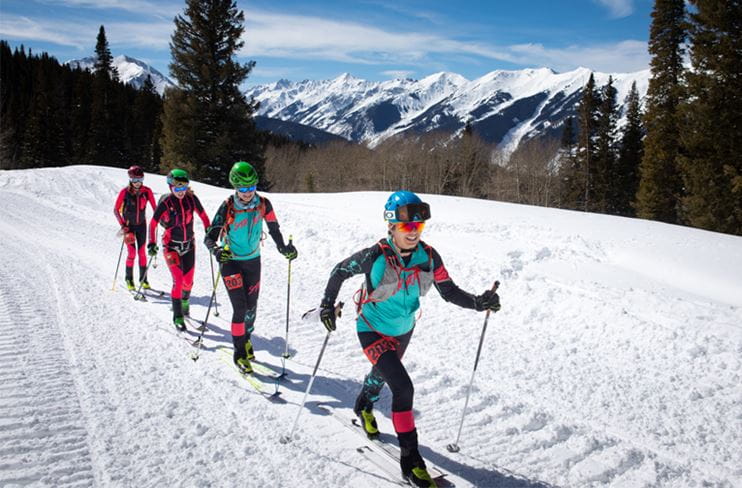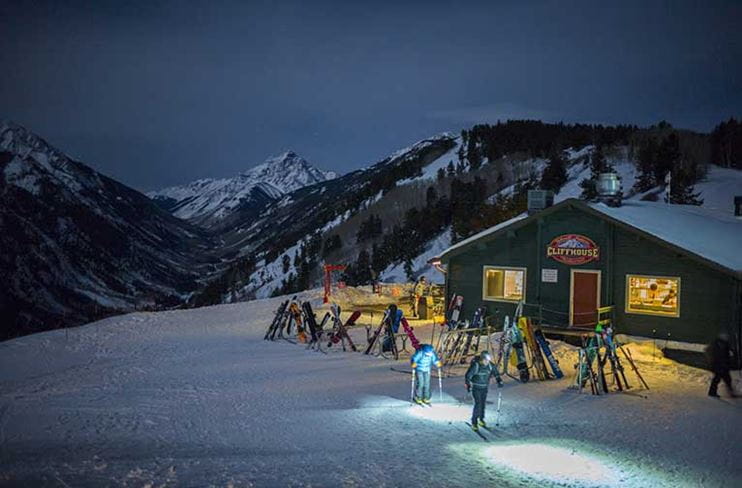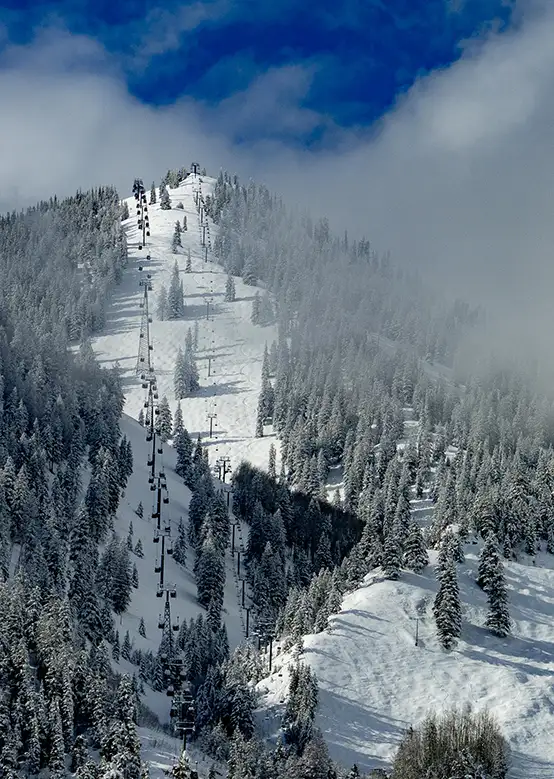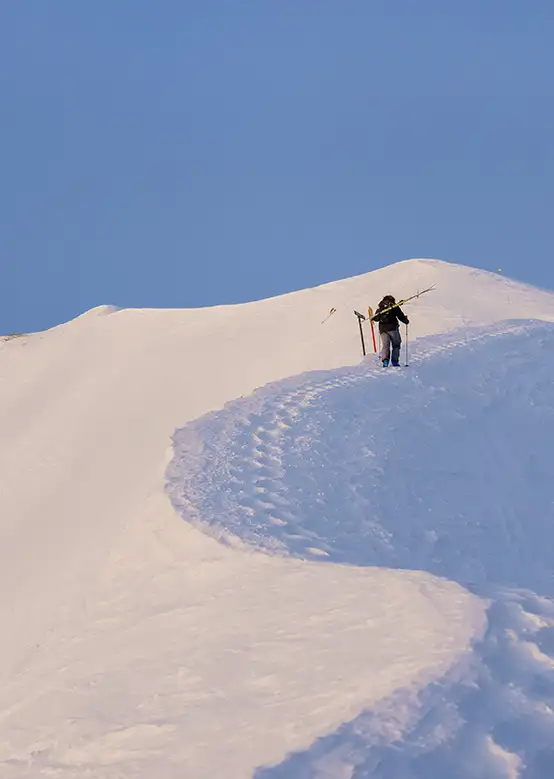It’s important to check the weather conditions and the temperature before you head out, so you dress and layer appropriately. You will get quite a workout alpine touring, followed by some serious windchill factor on your descent.

It’s All Uphill From Here

A pair of "skins" helps give cross-country skis the traction they need to make hill climbing possible. See below.
What is Uphilling?
Uphilling—also called skinning or alpine touring—is climbing up a mountain with skis, skins, boots on your feet, and poles in your hands. Once at the top of your climb, a simple transition of your gear allows you to ski back down the route you ascended. Uphilling requires a ski/boot/binding setup that is different from what you would normally use for downhill skiing. The boots have an adjustable cuff that can be locked stiff for skiing—or unlocked for walking. Similarly, a specialized alpine touring binding has two modes as well—one for skiing with a locked down heel and the other for uphilling where an unlocked heel allows for an easy walking stride. There are also specialty setups for snowboarders who wish to uphill called "splitboards." Specialized climbing skins are used for traction on the ascent and are removed when it comes time to ski.
Why Do People Uphill?

What Gear Do I Need?
An alpine touring setup consist of:
- Skis
- Boots
- Bindings
- A pair of skins sized to the skis
- Adjustable length ski poles (helpful as shorter poles are useful on the downhill, while longer poles are best for the ascent.)

What Are Skins?

How Do Alpine Touring Bindings Differ From Downhill Ski Bindings?
Where to Rent Uphill Gear?
Dialing in the right gear for uphilling can seem intimidating, but the team at Four Mountain Sports can help you from start to finish. We now offer uphill equipment for sale from Salomon and Black Crows to Technica and Marker. To rent gear, check out local shops like Ute Mountaineer and Cripple Creek Backcountry.
Where to Uphill?
To ensure uphill and downhill skiers are aware of each other and to minimize conflict between uphill and downhill traffic, all four mountains have designated and marked uphill routes. While all four mountains allow uphilling, an annual Uphill Pass is required and each mountainhas its own rules. Be sure to familiarize yourself with these policies before heading out. Tips and Strategies for Skinning Uphill
Unlike hiking where you lift your foot with each step, the idea of skinning is closer to Nordic skiing. You will want to keep the ski close to the snow and glide over the surface to maximize efficient use of one’s energy.
1. Use Proper Posture
Maintaining proper posture is crucial for balance and efficiency while skinning uphill. Keep your body upright and centered over your skis to avoid putting undue strain on your muscles. A slight bend in your knees helps you adapt to uneven terrain and keeps your weight evenly distributed, improving traction. Avoid leaning too far forward, which can reduce grip, or backward, which can disrupt your stability.
2. Adjust Your Stride
Short, deliberate strides are key to conserving energy, especially on steep inclines. A longer stride may feel faster but often leads to fatigue. Keep your skis in contact with the snow rather than lifting them, as this ensures continuous traction and minimizes wasted energy. Adjust your stride length to match the slope’s steepness, keeping movements smooth and controlled.
3. Optimize Skin Traction
To ensure your skins grip the snow effectively, apply firm pressure through each step. Avoid tipping your skis to the sides; keeping them flat on the snow surface enhances grip. If you notice slipping, adjust your technique to distribute weight more evenly across the ski.
4. Manage Kick Turns
Kick turns are an essential skill for navigating steep switchbacks. Begin by lifting your uphill ski and pivoting it to face the new direction. Then, bring your downhill ski around to match, focusing on smooth, balanced movements. Practicing kick turns on gentle terrain first will help you execute them more confidently in challenging conditions.
5. Use Climbing Risers (Heel Lifts)
Climbing risers on your bindings can make steep ascents much more manageable. Adjust the risers to elevate your heels, reducing calf strain and making each step more efficient. Remember to lower the risers when transitioning to flatter terrain to maintain proper posture and balance.
6. Pole Technique
Poles play a significant role in maintaining stability and rhythm. Plant your poles firmly with each step, timing your movements with your strides. Adjustable poles are ideal for skinning; shorten them for steep uphill sections to keep your balance and improve efficiency.
7. Regulate Your Speed
A steady pace is far more effective than rushing uphill. Moving too quickly can lead to exhaustion, while a consistent rhythm helps you conserve energy. Focus on efficient, deliberate movements instead of trying to ascend as fast as possible.
8. Layer Management
Skinning uphill generates significant body heat, so wearing moisture-wicking layers is essential. Choose breathable fabrics that keep sweat from accumulating and be ready to adjust layers as you climb. Overheating can zap your energy, so it’s worth taking a moment to manage your clothing to stay comfortable.
Before You Skin

Uphilling at Buttermilk
What To Bring
- A backpack or day pack of 15-20 liters. Enough to carry layers, water, a helmet, etc. for the hike up and ski down
- Layers of clothing, like a vest or light jacket for the uphill; heavier jacket for the downhill; and a buff, which can act as headband or neck gaiter
- Sun glasses
- Sunblock
- Chapstick
- Energy bar(s)
- Water bottle (or Camelback–be mindful of freezing tubes in colder weather.)
- Tissues or a bandana
- Light pair of gloves / heavy pair of gloves
- Ski pants and jackets with zippered air vents and armpit zips are helpful
- If uphilling at night, wear a headlamp and reflective clothing (if possible). You need to see and also be seen by groomers, employees on snowmobiles, and other skiers
Getting Into Your Gear
- Start your uphill skin day wearing your lightest layers like light gloves and a baseball cap. You will sweat, and your body heat will be much higher on the ascent. Once you get to the top, you will immediately start to cool and want to put on those extra layers for the ski down.
- If renting gear, make sure the shop technician demonstrates how to use your gear—especially the bindings. Alpine touring bindings vary greatly from brand to brand.
- You can find instructional videos or tips on using the gear via the internet.
- Be familiar with how your boots switch from walk to ski mode and how the buckling system operates.
Best Way to Get Into Uphilling
If you are looking for adventurous and social outings and to meet other like-minded uphillers, check out the full moon dinners or the Friday morning socials.
If You’re Looking For Instruction
You Might Also Like









